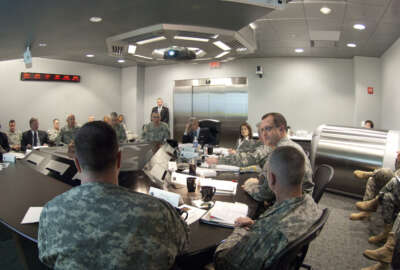
Army can’t wait for JEDI, so it’s building enterprise cloud services of its own
Army leaders say the services they're building now are "cloud agnostic," and can be moved to a DoD-wide enterprise cloud when and if one comes to pass.
There’s no telling when the Defense Department might finally have its JEDI Cloud up and running. But the Army’s not waiting around for it.
Instead, service IT leaders say they’re already beginning to build cloud architectures of their own that can reach from the office to the tactical edge — a major change to the Army’s fundamental technology infrastructure that is also likely to force it to rethink other aspects of its IT enterprise, including how it buys and develops software.
The Army’s ambitions are embedded in the very name of the new organization the service stood up earlier this year to guide its cloud activities: The Enterprise Cloud Management Office (ECMO). Officials said even though the Army has been consuming cloud services for years — both government ones and commercial ones — there was a clear need to synchronize those activities and scale them across the entire service.
From a technology perspective, the office has three main goals, according to Paul Puckett, the ECMO’s director: Provide cloud-based shared services that the entire Army can use, deliver software development tools that let the Army easily deploy cloud-native applications, and put cutting edge data management and data analytics tools in the hands of end users.
“Those three technical capabilities put together is what we see as a foundational element that all of the Army needs to lean into,” he said last week during an online event hosted by AFCEA. “What we find is that leveraging common services allows us to stop toiling with basic technology, configuration management, and starts to allow us to really start to focus on our applications and our data. We can start to receive feedback from our soldiers in the field and design new solutions and deploy those solutions in real time. All of that requires a secure foundation in the cloud, with common services. It requires the basic tools of modern software development. And it also requires our ability to tap into all of our datasets in real time.”
Along those lines, the Army’s headquarters issued a new data strategy and execute order (EXORD) last November — explicitly framing the new data governance model as a way to support migrations to the cloud.
Puckett said the overall goal is to let the Army “see” itself. Where is its most important data stored as of now? How can it be broken out of the silos where it sits today? If the Army can answer those questions, it can start to build cloud solutions that serve not just its garrison users, but extend all the way to the battlefield.
Read more: Defense news
“These can’t be solutions that are only found in the continental United States where we have 5G, and fiber abounds everywhere,” he said. “We need these capabilities for our ability to have online and demand computing resources even at our tactical edge, even in disconnected environments. In order for us to compete and win, we need to be able to share data from the foxhole to the enterprise and back. And that requires our systems, our architecture and our cloud to be designed and built to be a global asset and not just a capability at the enterprise.”
And even though the Army has a long way to go before it can say its enterprise cloud offerings are truly integrated with said Brig. Gen. Martin Klein, the director of the new Strategic Operations directorate in the Army’s G-3/5/7 organization.
The Army plans to test those concepts at large scale this fall, when it tries to demonstrate the application of AI and other emerging technologies to cloud-based data in a series of experiments called Project Convergence.
“It’s designed to actually get out in physical environments and experiment with the systems that we have,” Klein told reporters this week. “What we’ve found over the course of the last six months in particular is how important the cloud is to doing that. We’ve found that by orchestrating using cloud abstraction layers, we’re actually able to communicate more effectively. It’s really leveraging the information that we have to great effect throughout the Army, throughout the community of interest, whether that be modernization or operations, or frankly, throughout the Joint Force. We’ve found it to be quite liberating.”
If the Army’s ideas about extending cloud services to the tactical edge sound familiar, it might be because they’re quite similar to the goals the Defense Department has articulated for the entire military under its JEDI Cloud program. JEDI, of course, is still tied up in a long-running bid protest litigation saga.
But Army officials assume the cloud services they’re building now will need to fold in with a DoD-wide enterprise cloud at some point. Klein said the Army’s confident they’ll be able to do that, because the applications are being built in a “cloud agnostic” fashion.
Read more: Technology news
“If we go from a Microsoft Azure to AWS or Google, there’s going to be slight variations. But what we’re trying to do is build with those agnostic tools, so that as the department stands up an enterprise cloud we can immediately lift [into it],” he said. “A lot of what we’re doing within experimentation is using sample data and building it at an unclassified level, and then taking that code and lifting it to higher impact levels, getting authorities to operate and authorities to connect in those environments.”
Puckett said whether it’s an Army enterprise cloud in the short or medium term – or the JEDI cloud in the longer term – the move to cloud architectures will require the Army to rethink its approach to developing software.
“We need to lean into true agile methodologies, where we’re not just working in sprints, but fielding solutions early and often in order to improve how we’re meeting the needs of our customers,” he said. “Our ability to receive that feedback and then adapt to it and deploy a new capability requires us to fundamentally change the entire software development lifecycle and how we’re applying that across the United States Army. We’re starting to see really software-defined everything: software-defined data centers, software defined networks, and software is where we see the digital age moving forward. So we really need to have that core competency established, and that gets to the most important piece, which is our people.”
Copyright © 2025 Federal News Network. All rights reserved. This website is not intended for users located within the European Economic Area.
Jared Serbu is deputy editor of Federal News Network and reports on the Defense Department’s contracting, legislative, workforce and IT issues.
Follow @jserbuWFED
Related Stories





